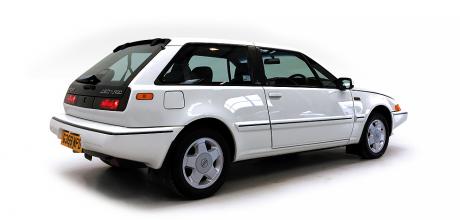Buying Guide Volvo 480

This rare Swede not only looks great but is also a surprising bargain
THE MARKET / Buying Guide
This Volvo is difficult to pigeonhole. The 480 is not a hatchback in the usual sense, but neither is it a traditional coupé. Although it clearly drew inspiration from the 1800ES, describing it as a shooting brake doesn’t feel quite right, either. Whatever it is, it’s certainly one of the most intriguing cars ever built by the Swedish manufacturer, and one that remains great value today. The 480 was a product of Volvo’s Dutch arm, born out of its acquisition of DAF in the 1970s. It represented a very different proposition to everything else built by Volvo at the time, being front-wheel-drive (a first for the company) and powered by the same Renault-sourced 1.7-litre four-cylinder found in the 340. Lotus had a hand in setting up the suspension, but the most radical aspect was the styling – with a low-slung front end and pop-up headlights.
Officially launched at the 1986 Geneva motor show and going on sale later that year, the ES model was powered by the naturally aspirated 1.7, putting out 108bhp and 103 lb ft. It wasn’t quick – with 0-60mph taking a shade over 10 seconds and a top speed of 110mph – but it drove well enough. The interior looked great and, as a dedicated four-seater, offered rear passengers comfortable quarters with a pair of sculpted seats and a large central armrest.
In 1988 Volvo launched the 480 Turbo – in effect the same 1.7-litre Renault engine but with a light-pressure Garrett turbo bolted on. Now with 120bhp and 130lb ft of torque, performance was somewhat more adequate (0-60mph in 8.6sec and 124mph), though it improved the drivability of the car more than anything else.
A minor facelift came in 1991, with lightly restyled bumpers and trim, seats and new mirrors. It also saw catalytic converters fitted to all models due to the upcoming EU1 emissions standard, which knocked the output of the 1.7-litre engine back to 102bhp. This precipitated the development of a new 2.0-litre engine for 1992. There was a final facelift in 1994, recognisable by its clear front indicators and airbag steering wheel.
Production ended in 1995, with the Celebration special edition (also called Collection in Europe) offering a full complement of options, including air conditioning, 15-inch wheels and a leather interior. Perhaps because it was quirky, the 480 never sold in significant numbers. It had been developed with a launch on the US market in mind – the integrated bumpers were expressly designed to comply with strict US regulations – but market conditions meant it was never officially sold there. It gained a reputation for poor build quality in the early years, too, and while most of the issues were rectified under warranty by Volvo, the 480 couldn’t quite shake that image.
It wasn’t directly replaced, although many consider the C30 from 2006 to have continued its lineage, sharing a similar glass hatch. The 480 remains a curio, but if you want a useful, characterful and affordable classic it’s a tempting prospect. There are still plenty out there, most in enthusiast hands, although finding a good one is an increasingly challenging prospect.
THE LOWDOWN
WHAT TO PAY
Running and driving naturally aspirated cars are available from £1500; up to £2500- 3500 for tidier examples. Turbos are more desirable, and prices for nicer examples are in the £3500-5000 range, although decent runners can still be found from about £2000. Special-edition cars can attract a slight premium.
WHAT TO LOOK OUT FOR
One of the most common problems is water ingress into the boot, from the top of the tailgate and rear light seals. Corrosion is one of the big killers, so check the rear wheelarches, suspension mounting points, sills and in the boot if it has been leaking. 1.7-litre engines aren’t the most sophisticated, or refined, but they are generally pretty sturdy. Easy to service, and generally cheap to repair. 2.0-litre cars suffered from high oil consumption early on, so check that it received the official ‘mod 2371’ dealer fix. The electrics are quite flakey, so test that all the switches function correctly, and the Electronic Information Centre on the dash works.

